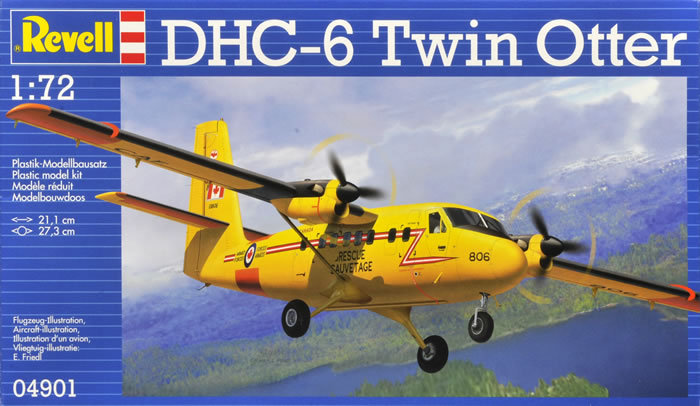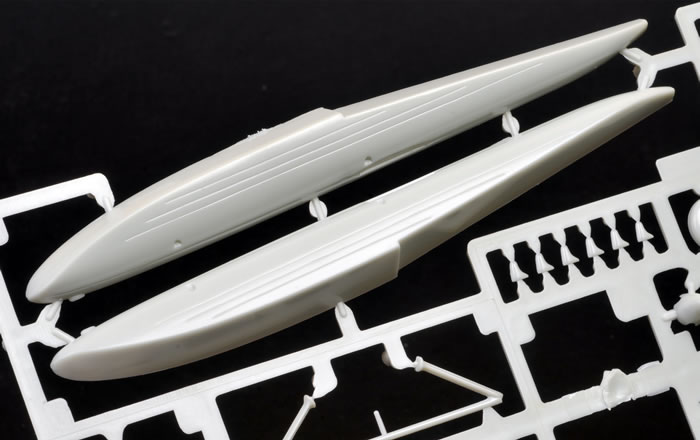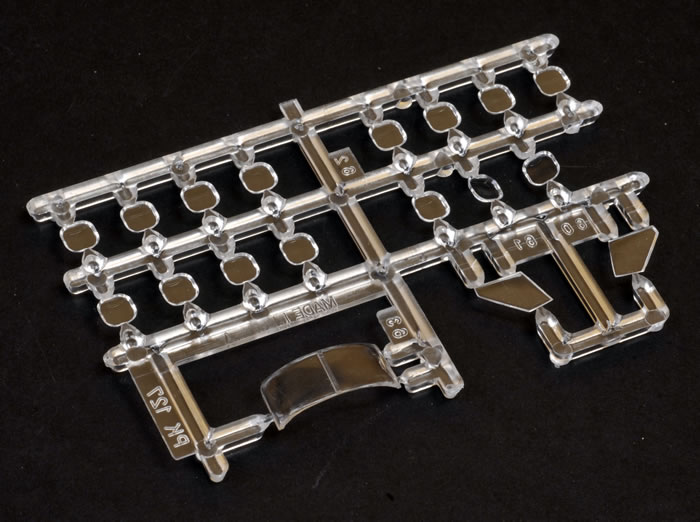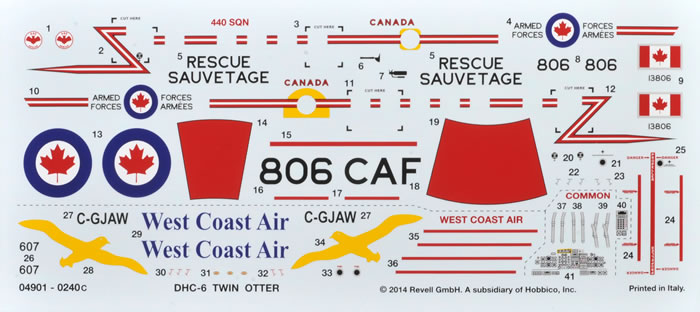|
DHC-6 Twin Otter

Revell, 1/72 scale
S
u m m a r y |
| Catalogue Number: |
Revell Kit No. 04901 - DHC-6 Twin Otter |
| Scale: |
1/72 |
| Contents and Media: |
83 grey airframe and 18 clear styrene parts, with decals for two subjects. |
| Price: |
Available on-line from Hannants for £7.92, and stockists worldwide.
Click for currency conversion |
| Review Type: |
FirstLook |
| Advantages: |
Accurate, refined surface detail, good decals, and good value. |
| Disadvantages: |
Rather a lot of sink-marks (but easy enough to fix). |
| Conclusion: |
This kit is one of Matchbox’s best efforts in The One True Scale, and can stand muster with most other kits of its generation. This is a good thing as it is the only Twin Otter kit I am definitely aware of. It is accurate, has very delicate surface detail, enough cockpit detail, and some pleasing configuration options. Just remember to feather the props.
The tooling has stood the test of time well, although sink marks were evident in several places; but these can easily be dealt with. Revell’s re-issue of it is pleasing for its use of a single light colour for the plastic, excellent decals, attractive pricing, and not least its global distribution.
It’s not often I get to recommend a Matchbox tooling, so I am very pleased to do so on this occasion. |
Reviewed by Mark Davies

Revell's 1/72 Buccaneer is available online from Squadron.com
Background
The de Havilland Canada DHC-6 Twin Otter is a Canadian 19-passenger STOL (Short Takeoff and Landing) utility aircraft developed by de Havilland Canada and currently produced by Viking Air. The aircraft's fixed tricycle undercarriage, STOL abilities and high rate of climb have made it a successful cargo, regional passenger airliner and MEDEVAC aircraft. In addition, the Twin Otter has been popular with commercial skydiving operations, and is used by the United States Army Parachute Team and the United States Air Force's 98th Flying Training Squadron.
Source: Wikepedia
Previous 1/72 Twin Otter Kits
This review kit is a Revell re-boxing of the original Matchbox kit from 1983, which has also been re-boxed by Modelcraft. It is possibly the only Twin Otter kit to be released, although I have seen box artwork for an Asian-brand 1/72-scale kit of the Twin Otter. I cannot advise whether or not it is a Matchbox re-box, a copy, or distinct tooling.
The Contents
The contents come packed in a medium-sized end-opening box with artwork featuring a Canadian Armed Forces machine. The main parts are enclosed in a single plastic bag along with the clear canopy and decal sheet.
The instructions include a parts map and have clear enough assembly diagrams with colour call-outs linked to Revell’s own paint range. The colours and markings diagram is a monochrome four-view diagram that clearly indicates where the decals provided go.
Revell have thankfully abandoned Matchbox’s kiddy-marketing, where the plastic was moulded in several colours; instead the parts are a uniform pale stone-grey. Small sink-marks are evident in several places, including the rear fuselage, tailplane, top of the undercarriage legs, bottom of the skis, and the finlets associated with the float-equipped version. None should be too demanding to remedy however. The prop blades have a very slight suggestion of mould damage, but again this should be easy enough to sand out (more on the props later); otherwise the 30-year old tooling has held up well. The parts are cleanly moulded and essentially flash-free. The transparent parts are very clear, although the windscreen has some distortion affects due slightly varying thickness.
The Kit
Having recently given the Revell re-box of a Matchbox Buccaneer kit a bit of a bagging, it is nice to be confronted with an example of what Matchbox did best. Their DHC-6 is a great example of how Matchbox could select a previously un-kited and relatively obscure subject, and then produce an accurate and generally refined kit of it. Other examples of this ability tended to be biplanes like the Fairey Seafox, Supermarine Stranraer, and AW Siskin; or sometimes monoplanes such as the Noorduyn Norseman.
The kit captures the attractive lines of the Twin Otter very well, and I cannot recall reading of any substantive criticism concerning its accuracy over the years. But perhaps the standout feature of this kit is id very delicate surface detail – Yes you read correctly, a Matchbox tooling with delicate surface detail!
Surface detail is limited as most of the structure is smooth. But where represented the panel lines consist of very fine raised lines indeed. Doors and hatch outlines are finely engraved, whilst the fluted corrugations of the control surfaces are nicely done. Some very small vortex generators on the tailfin, door hinges and handles, and areas of airframe reinforcement are provided as raised detail, but again very delicately. The floats feature some engraved strake lines.

The cockpit detail is quite reasonable for the scale, with a bulkhead, floor, seats, instrument panel, simplified rudder pedals, and twin yokes all represented. The instruments are catered for by a decal, or the moulded raised detail can be highlighted. A nice touch is that the decal sheet includes seatbelts. I doubt if much of this detail will be visible due to the small size of the cockpit side widows and windscreen.

No cabin interior is provided, but then none is really needed. The cabin windows are individual clear parts, which usually makes for a better fit than when they are formed in strips; another plus for this kit.
Airframe construction looks straightforward. The kit includes a choice of wheels, wheels and skis, or floats. There is also a choice of 100 or 200-series noses (short and long respectively), although the long nose does not apply to float versions I believe; nor either of the kit’s decal options for that matter. There are four finlets that attach to the tailplane of the float-equipped version. Their locations are indicated by a faint raised outline, which should be removed by sanding for non-floatplane versions. The detail on the wheels looks a little soft where the tyres meet the inside rim faces, but careful painting should hide this.
The propellers need to have their blades sanded to remove a little bit of surface lumpiness, which I speculated earlier may be due to tool damage. I would also suggest some general thinning down of the blades to improve scale finesse. They should really be removed and refitted after rotating 90 degrees in the fully feathered position if the finished model is to depict an aircraft with engines off.
There are two quite finely moulded boarding steps and several aileron and flap hinges to add, along with a couple of wing fences. These last items could benefit from some gentle sanding to thin them down a tad, but this need is not unusual given the limits of injection moulding.
The overall style and level of detail of this kit reminds me of the Hobbycraft/Academy DHC-DHC-3 Otter kit in many ways, albeit the Hobbycraft kit has recessed rather than raised panel lines.
Colours & Markings
The kit provides two decal options, these being:
-
No 440 Squadron, Canadian Armed Forces, Namao, Canada, May 1983
-
West Coast Air floatplane, Victoria Harbour, Canada, October 2006.
The decals are printed in Italy, but do not say who by. They are very crisply registered, appear to have excellent colour density, and are slightly glossy; which I much prefer to the matt-finish decals Revell has often supplied in the past.

If the kit markings do not appeal you may be in luck, as there are a lot of Twin Otter operators, and there have been quite a few aftermarket decal options over the years. Hannants currently lists some options from Lima.
This kit is one of Matchbox’s best efforts in The One True Scale, and can stand muster with most other kits of its generation. This is a good thing as it is the only Twin Otter kit I am definitely aware of. It is accurate, has very delicate surface detail, enough cockpit detail, and some pleasing configuration options. Just remember to feather the props.
The tooling has stood the test of time well, although sink marks were evident in several places; but these can easily be dealt with. Revell’s re-issue of it is pleasing for its use of a single light colour for the plastic, excellent decals, attractive pricing, and not least its global distribution.
It’s not often I get to recommend a Matchbox tooling, so I am very pleased to do so on this occasion.
Revell model kits are available from all good toy and model retailers. For details visit www.revell.de/en, @RevellGermany or facebook.com/Revell
Review Text and Images Copyright © 2014 by Mark Davies
Page Created 1 December, 2014
Last updated
3 December, 2014
Back to HyperScale Main Page
Back to Reviews Page |
